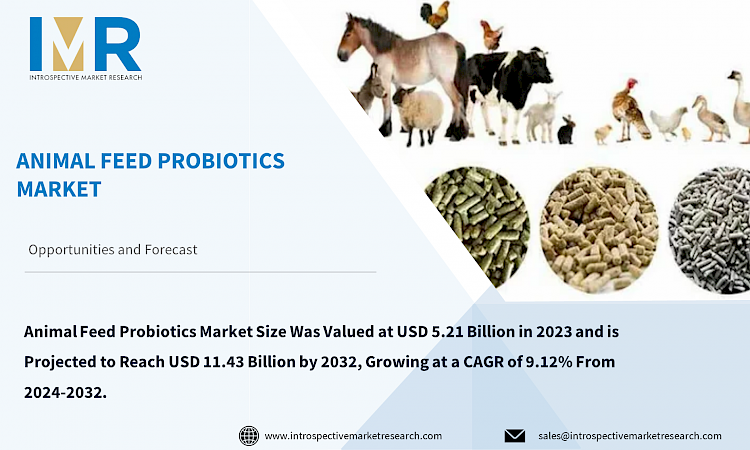
Global Animal Feed Probiotics Market
According to a new report published by Introspective Market Research, titled, “Animal Feed Probiotics Market by Source, Form, Function, Livestock and Sales Channel: Global Opportunity Analysis and Industry Forecast, 2024–2032,”
Animal Feed Probiotics Market Size Was Valued at USD 5.21 Billion in 2023 and is Projected to Reach USD 11.43 Billion by 2032, Growing at a CAGR of 9.12% From 2024-2032.
Animal feed probiotics improve livestock gut health by enhancing digestion and nutrient absorption. These beneficial microorganisms, incorporated into feed formulations, strengthen the immune system and help prevent gastrointestinal issues in animals, leading to enhanced animal health and performance.
Animal feed probiotics have wide-ranging applications in livestock farming, aimed at optimizing animal health and productivity. By rebalancing the gut microbiota, probiotics facilitate efficient digestion and nutrient absorption, resulting in enhanced growth rates and feed conversion efficiency. Furthermore, they bolster the animals' immune systems, reducing the incidence of diseases and lessening the reliance on antibiotics in husbandry practices.
The benefits of utilizing animal feed probiotics surpass mere health advantages. They present a sustainable approach to livestock management, diminishing the environmental footprint associated with traditional farming methods. By aiding in the decomposition of organic matter in manure, probiotics reduce methane emissions and nutrient runoff, thereby curbing pollution and advocating for environmentally friendly farming techniques.
The Animal Feed Probiotics Market is segmented into Source, Form, Function, Livestock, Sales Channel and region. By Source, the market is categorized into Bifidobacterium, Lactobacillus, Bacillus, Enterococcus, Streptococcus, and Others. By Form, the market is categorized into Dry and liquid. By Function, the market is categorized into Gut Health, Immunity, Productivity, and Nutrition. By Livestock, the market is categorized into Poultry, Ruminants, Swine, Aquaculture, and Pets. By Sales Channel, the market is categorized into Modern Trade, Direct Sales, Specialty Stores, Online Retailers, and Convenience Stores. By region, it is analyzed across North America (U.S.; Canada; Mexico), Eastern Europe (Bulgaria; The Czech Republic; Hungary; Poland; Romania; Rest of Eastern Europe), Western Europe (Germany; UK; France; Netherlands; Italy; Russia; Spain; Rest of Western Europe), Asia-Pacific (China; India; Japan; Southeast Asia, etc.), South America (Brazil; Argentina, etc.), Middle East & Africa (Saudi Arabia; South Africa, etc.).
The increasing demand for animal protein and other livestock products acts as a significant catalyst for the rapid growth of the animal feed probiotics market. With the expansion of global populations and changing dietary preferences, there's a notable rise in the consumption of meat, dairy, and related products worldwide. This surge in demand highlights the need to optimize the health and productivity of livestock to meet the escalating requirements of the food industry.
Animal feed probiotics are instrumental in addressing the challenges associated with the intensification of livestock production. By enhancing gut health, boosting nutrient absorption, and strengthening immune responses in animals, probiotics play a vital role in maximizing the efficiency of meat and dairy production. Farmers and producers increasingly rely on probiotic supplements as a proactive approach to ensure the well-being and perDrynce of their livestock.
Probiotic strains lies in their ability to address specific challenges encountered in animal agriculture. These strains can be customized to tackle prevalent health issues in various livestock species, such as improving digestion, strengthening immune responses, and alleviating the impacts of stress. By targeting these specific concerns, novel probiotic strains provide tailored solutions that effectively enhance overall animal health and perDrynce.
Global Animal Feed Probiotics Market, Segmentation
The Animal Feed Probiotics market is segmented based on Source, Form, Function, Livestock and Sales Channel, And Region.
Source:
The Lactobacillus segment is set to lead the expansion of the animal feed probiotics market. With its well-documented advantages in fostering gut health and boosting immune function in animals, Lactobacillus strains have garnered widespread recognition and acceptance in the livestock sector. These probiotics play a vital role in optimizing digestion, enhancing nutrient absorption, and reducing the risk of gastrointestinal disorders across various animal species. The Lactobacillus segment is its adaptability and effectiveness across diverse livestock categories, encompassing poultry, swine, cattle, and aquaculture. With consumers increasingly demanding high-quality animal products produced through sustainable and eco-friendly methods, there is a rising preference for probiotics like Lactobacillus, renowned for their natural and beneficial impacts on animal health and perDrynce.
Livestock:
The poultry segment has emerged as the primary driver propelling the expansion of the animal feed probiotics market. Holding a significant share, the poultry industry acknowledges the importance of probiotics in elevating the health and efficiency of poultry flocks. Probiotics play a pivotal role in poultry farming by fostering gut health, enhancing nutrient absorption, and fortifying immune responses in birds.
The poultry segment is the widespread adoption of probiotics to tackle prevalent challenges encountered in poultry production. Producers depend on probiotic supplements to optimize feed conversion rates, mitigate disease occurrences, and improve overall poultry performance.
Region:
The Asia Pacific region is forecasted to lead the animal feed probiotics market regionally. This dominance is attributed to several factors, including the region's large and expanding population, increasing urbanization, and growing disposable incomes. As dietary preferences shift towards higher protein intake, there is a corresponding surge in the demand for meat and dairy products across Asia Pacific. Furthermore, countries in the Asia Pacific region are experiencing rapid advancements in livestock farming techniques and technologies. Producers are increasingly acknowledging the advantages of incorporating probiotics into animal feed formulations to enhance overall animal health, improve feed conversion efficiency, and decrease reliance on antibiotics.
Some of the leading Animal Feed Probiotics market players are
- Lallemand Inc. (Canada)
- Evonik Industries AG (Germany)
- Ohly (Germany)
- Novozymes (Denmark)
- Danisco A/S (Denmark)
- CHR. HANSEN HOLDING A/S (Denmark)
- DSM (Netherlands)
- Provita Animal Health (UK)
- Orffa (Netherlands)
- Koninklijke DSM N.V. (Nertherlands)
- Lesaffre (France)
- BIOMIN Holding GmbH (Austria)
- Calpis Co (Japan), and Other Active Players.
Key Industry Developments
- In September 2022, DSM has acquired Prodap, a leading Brazilian animal nutrition and technology company. With this strategy, the company combines technology offerings, consulting services, and specialized nutritional solutions to improve animal farming efficiency and sustainability.
- In October 2022, the partnership between Evonik and BASF allowed Evonik certain non-exclusive licensing rights to OpteinicsTM, a digital solution to improve comprehension and reduce the environmental impact of the animal protein and feed industries.
Key Findings of the Study / Key Industry Developments.
- The poultry segment is the primary driver of market growth. Poultry producers increasingly rely on probiotics to improve feed conversion rates, enhance nutrient absorption, and strengthen immune responses in birds, addressing common challenges in poultry farming and boosting overall poultry performance.
- The Asia Pacific region is projected to lead the global animal feed probiotics market. Factors such as a large and growing population, increasing urbanization, rising disposable incomes, and shifting dietary preferences towards higher protein intake contribute to the region's dominance.




